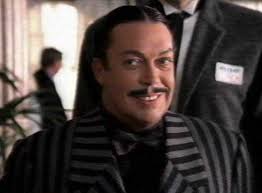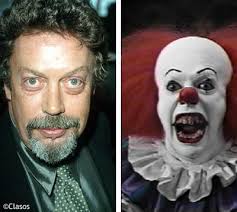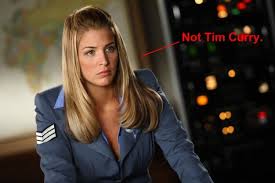It's not easy to come up with classic characters. Think of basically any character that Tim Curry has played

He rocked in Congo. "Abso-
lutely true"

Rocky Horror Picture Show: "Antici- -
PAtion"

The Three Musketeers: "..." I can't quote him from this.

I don't know what movie this is even from.

It: "Down here we all float, Georgie"

? He kind of looked like this in
Clue, he was the butler, but also Mr. Body, in one of the conclusions. Though I'm not sure he had a beard in
Clue.
And he really challenged himself in this role. Great character actor.
After that brief example of how important memorable characters are to a great story - I come to these bits of advice courtesy of
Suite101.com:
You need apparently only three things. 1)
An interesting and plausible character back story: The character backstory is necessary due to the effects it has on the character’s present self. Unless vital to the plot or story of a particular screenplay, no character is isolated from the rest of the world. He is affected by almost everything that surrounds him including his family background, education, friends, religion, birthplace and way of life.
Therefore, his actions, beliefs, thoughts and the way he reacts to events are somehow related to his past and the reasons why his present self is portrayed the way it is. Backstory should not be blatantly revealed but provide yet more subtle insight on the deeper workings of the character’s heart and mind.
Because of the fact that nuances in present characters can ultimately be explained by a rich background, in return a rich background can provide existing characters with a more dynamic personality.
2) the character goal; All characters need to have a clear and measurable goal. This not only justifies their existence in the story but also allows the audience a chance to relate to the character as their goal or ‘reason for being’ is revealed throughout the story.
The Protagonist’s goal sets the story in motion and it is important to make sure this goal, though achievable is also something that is worth fighting or even dying for. After all, the stakes of the story are placed upon the importance of this goal. The protagonist will risk his entire being in order to achieve it so the gains he will receive should the goal be reached needs to be of equal or greater value. For example common goals in action films include saving innocent people or someone important to the protagonist. In romantic films the goal is often gaining the love of the protagonist object of affections.
The Antagonist’s goal which is in direct opposition to the protagonist’s bears the true task of creating conflict in the story which in turn allows the plot to develop further. Without conflict, the story will idle and will ultimately prove to be uninteresting and dull.
3) and the character motivation.The character motivation also allows audiences an inside view of the character on a deeper level. Characters that are injected with plausible motivations are allowed to have an added dimension and the more personal the motivation the more likely it is for audiences to be able to understand and therefore relate to the character. These motivations can be apparent to the character and audiences when played straight but can also be used to add twists and turns to the story should the writer hold back the reveal.
Similar to the character goal, the character motivation also has to have as much intensity as needed to support the genre base of the story. Because screenplays deal with events that are critical to the character’s existence, the character motivation needs to be the essence and spirit necessary to push him right up to his limits as it drives him to achieve his goal.
Character motivation creates the reason why the character will run through burning buildings, head into enemy territory or risk his life to save a stranger. A motivated character has a true reason for being and a true reason for wanting to be alive and fighting fit for the next scene. The fact that he is memorable and dynamic drives audiences into following him throughout the journey.
I think that one of the more difficult parts of writing a character with a clearly defined goal is that you don't necessarily start with a character that has a clearly defined goal. And sometimes without a dramatic need, either.
These needs or goals can be something that emerge from out the plot - but could be something that was seeded way back in their past, which only emerges as a result of some mitigating circumstance that brings that old dramatic need into the present for the character.
I look back and realize that my protagonist Luc Lefevre was just doing his job when a circumstance revealed an item out of his past which he was ashamed of - which propelled him toward a clearly defined resolution. My other protagonist, Dr. Casey Miller, has been a different challenge - because he needs a few things in his story - and his back-story isn't developed in any particular way. In fact, his character flaw might be that he doesn't have much of a back-story. And that fits his character really well.
However, by the nature of his job (and his inability to be great at some parts of his job) he finds himself desperate to achieve a clearly defined goal - but along the way, finds a personal ambition that holds either equal, or even greater, importance than his career - but those things are all in conflict with a series of antagonists who required Miller's professional assets to achieve a goal of their own.
Given the choice, I would get Tim Curry to portray Casey Miller in film. It would be awesome.








No comments:
Post a Comment